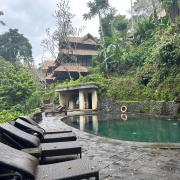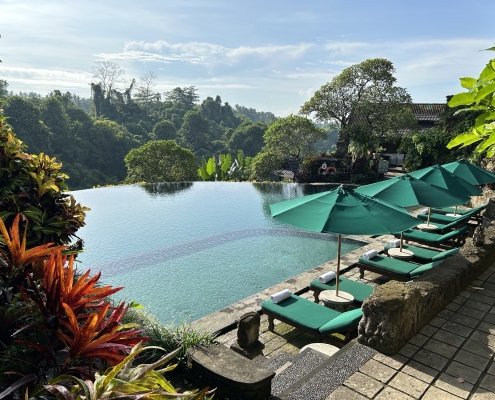Island of the gods, guardians and peripatetic primates
Peculiar pre-match entertainment for a Cats-Tigers clash when you’re kicking back peanuts and Bintangs in the Bali mountain jungle town of Ubud.
A dozen or so Barbary macaques parading alongside the bar – upside-down infants clutching their mothers, cocksure males trooping the colour – suggested a peculiar cheer squad on the march. Perhaps not that peculiar in Tigerland, though.
Oh, sorry, I take that back but it’s been said now. Maybe I can’t.
Bar staff have abandoned the traditional shanghai slingshot deterrent favoured by hotels for coloured laser beams, which seems to be taking the fun out of things. When you’ve been hissed at, spat on and tackled by the little blighters and their rabid claws, sympathy levels for primates aren’t high.
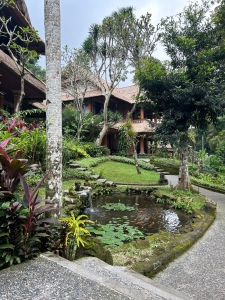

The lasers send them scarpering, non-violently. My remonstration to a staffer about new tech over old tech is countered with: “Monkeys are sacred, they’re guardians of our temples.”
Oh yeah, that’s right. If only they stuck to the temples and off the hotel balconies spooking the tourists.

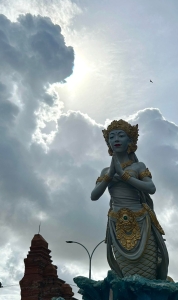
Peripatetic chimps are far from the only organic entertainment on offer on the Island of the Gods, though. Look closely around the place and you’ll find all sorts of oddities.
Think tourists buying satay sticks and sausages to feed stray dogs. Café tables and chairs washed out to sea by the incoming tide. Hawker knock-offs three times more expensive than home. Locals eating with ducks off the same table. Girls in dental floss bikinis practising yoga in front of beachside diners. Missile-like fireworks blasting out to sea as Boeings come out of the sunset to land in the shadow of giant deity statues.
Then there are plantain squirrels whipping through the jungle foliage, giant snails, luminescent black and yellow centipedes, koi pond fish feeding frenzies, dragonflies galore, fighting cocks, masterful bird mimics.

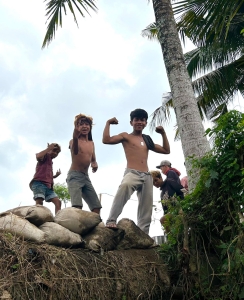
Art’s everywhere you look. In religious offerings, in signs, sculptures, gardens, temples, carvings, buildings, shop fittings, traditional clothing, masonry, paintings, furniture … absolutely everything.
Construction’s going on everywhere, too. Jackhammers next door, pile-driving down the river gorge, massive refits to old hotels, including one opposite the ‘quiet’ room I booked.
I’m especially drawn to a giant carapace bamboo structure rising from a paddock smack in the middle of Ubud. Workers line up for a 15-minute rev-up from the boss before I wander over, stupidly barefoot on the hot black bitumen path, to reconnoitre proceedings. A tall lean bloke introduces himself as the property owner, says the double-shelled, thatch-roofed design is going to be a yoga studio.
Good bet it might draw a bit of attention, too. It’s been whipped up by bamboo’s wunderkind architect, Pablo Luna – known for blending Bali’s tri hit karana philosophy of harmony between people, nature and spirituality with environmental, sustainable and biomimicry principles into his work.
It’s a fair matrix. Almost as cross-pollinated as his background: a Chilean-born architect of Peruvian/Lebanese heritage who studied in New York before taking his work to Indonesia and South-East Asia, Costa Rica, Mexico, India and Chile.


No doubt it will slot right in with Ubud’s wealth of health and wellness practitioners. No shortage of anything in that jungle; from soothing didgeridoo drones through fusion vegan iterations to breatharian starvation rackets, propped by a multitude of souls seeking happiness, self-awareness and more Zen in their lives. For all the healing they provide, I think Lomotil’s somehow got the jump on them.
The real thing about somewhere like Ubud, and the broader Bali, is the island itself and its natural geographical attributes. A mountain bike ride, a handful of temples and waterfalls, maybe some whitewater rafting, a few palms and a rice terrace or two are about the extent of things the punters will investigate outside the insane gridlock of Seminyak and Canggu.


Which is a pity. I’ve had a dog-eared topographical map of the island for a while now, a bright green-coloured thing of valleys, mountains, volcanoes, precipitous gorges, rivers, lakes – a surveyor’s paradise, or maybe nightmare. Contained within its cartographic swales and saddles are a trove of ridiculously stunning tracks and defiles, villages, waterfalls, panoramas, rivers, ravines, coastal outlooks, islands to ponder, jungle …
I’ll be happy to keep ticking off place names for next decade or two given half the chance. If the bloody monkeys don’t give me rabies, that is.

